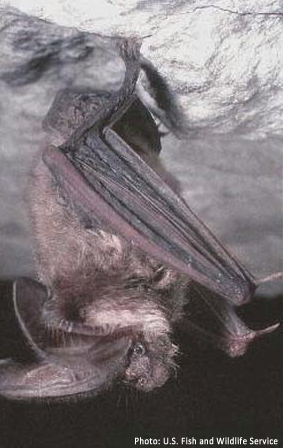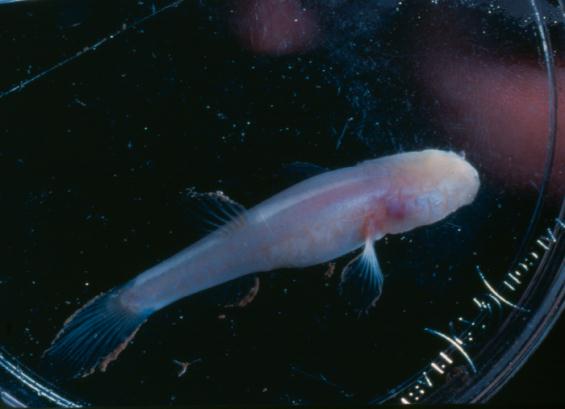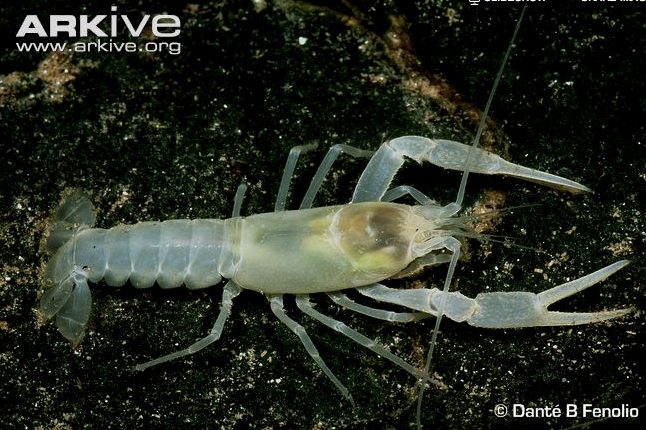Interactions
The Hell Creek Crayfish is an opportunistic omnivore, eating
nearly anything that it is able to. Little is actually known
about the diet of the crayfish, but there are confirmed
populations of
ozark cavefish, rock bass, lucifuga, sculpins, central
stonerollers, and other crayfish in both of the caves (USFWS,
2006). Fish eggs are a favorite for crayfish, and are a likely food
source for them. Crayfish are detritivores, and will consume the
decaying matter of other organisms, so scientists believe it is
likely that much of their diet comes from consuming fish after
they die. Crayfish also eat plant matter, so any vegetation in
the cave may also be a viable source of nutrition. The
hole that was drilled for mining actually is beneficial to the
ecology of the area now because it allows organic matter such as
leaves and small organisms to fall into the deeper regions of
the cave where food is less common (Graening
 et al. 2006). Grey
Bats used to inhabit the cave and one of the primary sources of
food for the crayfish was the feces from the bats that fell into
the water. But due to some ecological changes, the bats have
left the cave, and taken important nutrients with them. Scientists are trying to figure what caused the bats to leave,
and want to reverse it to bring them back to Hell Creek Cave
(IUCN, 2010).
et al. 2006). Grey
Bats used to inhabit the cave and one of the primary sources of
food for the crayfish was the feces from the bats that fell into
the water. But due to some ecological changes, the bats have
left the cave, and taken important nutrients with them. Scientists are trying to figure what caused the bats to leave,
and want to reverse it to bring them back to Hell Creek Cave
(IUCN, 2010).
When hunting for food, crayfish use their powerful pincers to capture and crush prey. They can wound or kill many organisms, such as worms, insects, or other smaller crayfish. They also use their pincers to rip off matter from dead plants or animals. Being such a small animal, the Hell Creek Cave Crayfish is near the bottom of its food chain. The cave has an open entrance, and small mammals such as raccoons and opossums can enter and hunt for the crayfish. Also, some of the rock bass get to be over 8 inches in length and love to feed on the tiny crustaceans.
With so many potential predators, crayfish have developed many methods
of defense. Although they have no pigments and appear to be white, camouflage and hiding is the primary way crayfish avoid predation,
as they
will hide under rocks, or dig small burrows. If a predator sees a
crayfish, they swim backwards quickly while simultaneously flinging mud
at the threat to try to escape. They can use their pincers to try to
pinch and fight the attacker but this is not very effective against
larger predators. One of the most distinguishing traits of crayfish is
their hard exoskeleton made of chitin. This shell helps protect them,
but it can also be very dangerous because the crayfish need to molt in order to
grow. When the crayfish molts, it is vulnerable during the process, and
also
after because the new shell is soft, so the crayfish needs to choose an
appropriate time and place to molt.
predator sees a
crayfish, they swim backwards quickly while simultaneously flinging mud
at the threat to try to escape. They can use their pincers to try to
pinch and fight the attacker but this is not very effective against
larger predators. One of the most distinguishing traits of crayfish is
their hard exoskeleton made of chitin. This shell helps protect them,
but it can also be very dangerous because the crayfish need to molt in order to
grow. When the crayfish molts, it is vulnerable during the process, and
also
after because the new shell is soft, so the crayfish needs to choose an
appropriate time and place to molt.
Although the crayfish is not blind, most troglofauna rely very little on
eyesight because it is so dark in their environmnent. Organisms have
developed amazing sense of hearing and chemo-receptors, along with other sensory devices. Many people
know that bats use echo location to find their food, and other organisms
can
use their sense of smell. The
Blind Cave Fish uses an enhanced sense of smell, taste, and feel. It
is truly amazing what evolutionary paths these isolated cave dwelling
organisms can follow.
Parasites and other microbial issues have not been extensively studied
yet, but in other species endemic to caves, the transfer of parasites
from organism to organism is possible due to their close proximity
(USFWS, 2006). This is the reason it is common practice for cave divers to
completely disinfect their equipment before entering, attempting to
prevent the introduction of new parasites into the environment.
Humans have not typically used the Hell Creek Crayfish because there is such a small
population of them, but humans do use other crayfish for a variety of
food and activities. In the south (US), crayfish boils are very common, and they are
considered a delicacy. They are also used for bait because bass and
other fish are so attracted to the meat, and many lures are made to resemble
the
crayfish. Ecologically, they are great indicators of water purity
because they are so sensitive to pollutants, and they also help clean up
their environment by eating dead and rotting matter. The Hell Creek
Crayfish is a very interesting organism, but we don’t know enough about
it, and its network of relationships. There is ongoing research, and
plans in place to protect this delicate animal, so hopefully we can
learn more in the future.
